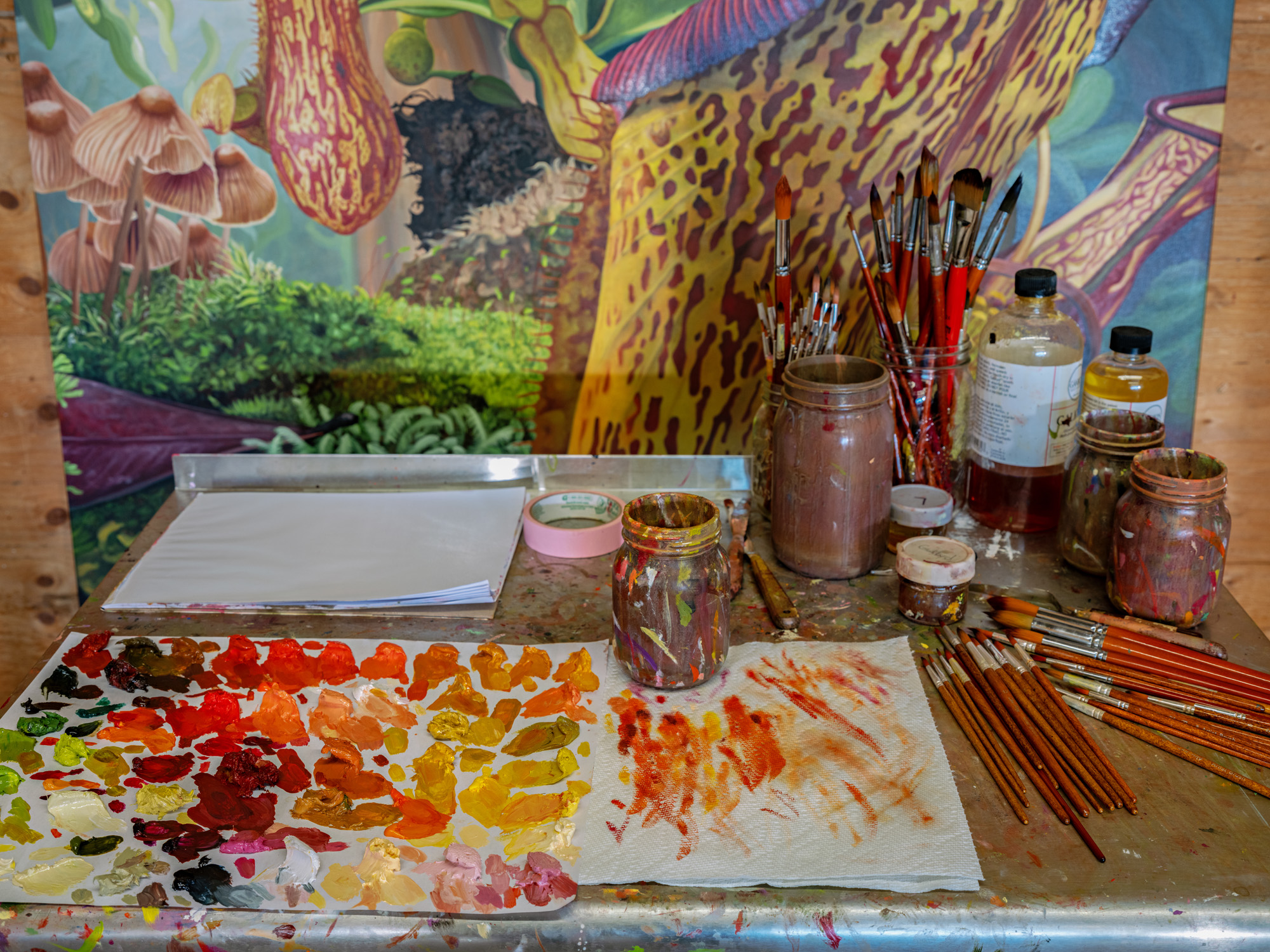A native of Albany, New York, Bickmore studied art at Hamilton College, spending her junior year abroad at the Slade School of Fine Art in London when she “really fell in love with the city.” She returned to London to earn her MFA from the Royal College of Art in 2019. She now splits her time between studios in London and Rockland, Maine, where she works in the Steel House, home and workspace of Elysa and Paul Coster, when she isn’t at an artist residency or traveling to study her subjects in their natural environments. “I think that experience of going and seeing these plants in person adds this other layer of appreciation and care,” she says. Recent trips include searching for orchids in the Fakahatchee Strand Preserve in Florida and scouting the elusive Rafflesia, the largest flower in the world, in Borneo. I caught up with the intrepid artist between an upcoming residency at Palazzo Monti in Brescia, Italy, and a trip to the remote, ecologically distinct Socotra in Yemen.

SM: You’re known for your immersive florascapes. When did you start painting flowers? And why this subject?
KB: My work has always been about how my body relates to the natural world as a queer woman. Even at Hamilton, I was exploring themes of femininity and nature. When I got to London to study at the RCA, I struggled to figure out where to push the work. So, I created this rule for myself to make a drawing every day. I always had fresh flowers on my bedside table, and I began drawing the flowers each night. One day, I was meditating, which is a big part of my practice, and I had this “aha” moment where I was like, I need to blow these up; I want to be inside these plants. So, the next day, I went to the studio, stretched a huge canvas, and started painting these massive flowers.


SM: You’ve said, “My relationship with nature is active, there’s an agency to it.” How so?
KB: When I paint flowers, I want them to have the sensation of physical bodies, to feel alive and growing. There’s something about how flowers often mimic male or female sex organs. And when they’re at that scale, it is quite bodily. They appear to emerge from the canvas into the physical world. So, the space of the canvas is also a means of breaking down constructs.

SM: You’ve mentioned the adventurous 19th-century English botanical artist Marianne North as an inspiration. Are there other artists you look to?
KB: Georgia O’Keeffe has always been someone I’ve looked to, especially for how she made paintings to get people to look closer at things. I think about that a lot in terms of my own work, of wanting to create visually rich experiences with these plants in hopes that people will slow down and look more closely. If we can do this with plants, I imagine we might perceive other things differently, like notions of femininity.
SM: In recent years, you’ve had a studio in the Steel House in Rockland. How did that come to be?
KB: I had been at a residency in New York City, where I had a studio much bigger than my one in London, and I got it in my head that I wanted a larger studio by the water. My best friend, artist Sam Finkelstein, who I knew from Hamilton, was living in Maine, so I asked them if they knew of one. Elysa Coster, who owns the Steel House with her husband Paul, responded that she would be studying in Japan for the summer and had this studio and a spare room if I was interested. Elysa and Paul have been so supportive. They’ve become friends and, in a way, also my patrons.


SM: Travel is a primary source of inspiration, but it’s just one element in your process. Can you walk us through creating a painting?
KB: I do research, but much material comes from my experience in the landscape, talking to botanists and indigenous people. Then, I work with my florist, Samuel Thomas, who is based in London, to build a living diorama that mimics the feel of the environment I was in. With photos from my trip and of the diorama, I use Procreate to make the composition, working out color, balance, movement, and how the plants interact. That way, I have a pretty good plan when I blow it up to a larger scale. After that, I make small watercolor studies to help determine how I will layer the paint to convey that living sensation. Because I’m not just painting the image but also creating the environment. Ultimately, I want the paintings to have a sense of awe.
—
Kate Bickmore is represented by Andrew Reed Gallery, Miami, and CHART, New York City.





